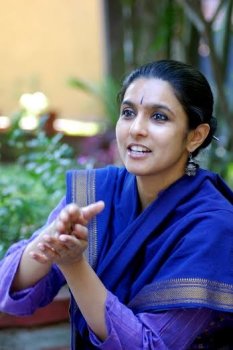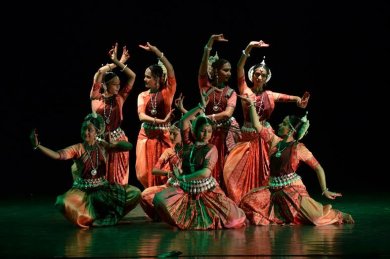
|
 |

|
 |
Vadya Pallavi: the concept and process - Parwati Dutta e-mail: parwatidutta@gmail.com Pics courtesy: Mahagami August 7, 2014 In the late 1980s, when I was curiously studying the history and journey of Odissi dance, I came across a brief description of pallavi with an elaboration mentioning 2 kinds of pallavi - Swar Pallavi and Vadya Pallavi. While the first seeks to be a visual trans-creation of the raga - the melodic mood - the latter is inspired by the rhythmic element and the percussion of Odissi. During my training, I discovered that all pallavis taught to us were named after the raga in which it was composed, hence can be considered as Swar Pallavi. As per the name and its underlying concept, a pallavi gently unfolds in space and time through melodic, rhythmic and gestural patterns. My quest to know more about this extremely imaginative dance concept led me to the realization that Vadya Pallavi has not been attempted post revival of Odissi. Through inputs from Late Dr. Jiwan Pani and Late Guru Kelucharan Mohapatra, I started looking for more information about this form of pallavi. Since the late 1990s I started working on systemizing the Odissi taal system and it was a great blessing to work closely with Guru Banamali Moharana for the same. While working on the taal system, the 'baani' (syllables) of mardal and the traditional style of its rendition, I discovered many possibilities that can imaginatively expand its scope.  Parwati Dutta The percussion of Odissi has a variety of syllables - those from the dance element, from 'ghata mardal' tradition, khol tradition, from 'Raas', from various kinds of rendition in festivals and temple rituals. I started analyzing the tonal quality of each category and possibilities of those in various speeds, 'jaati' and taals. Working on Vadya Pallavi, I wanted the abstract syllables of vadya to be more important than the musical phrases and to be the dominant element in the dance composition. Long 'arasa-s' set to traditional taals like 'jati taal' were specially composed to work on various poetic combinations of the baani and flavor of each. The process inspired me to improvise on jaati taking different categories of baani suiting each pattern. For instance, I chose 'ghanta-mardal' for 'khanda-jaati,' khol and raas syllables for 'tishra,' patterns from traditional accompaniment with vocal for 'mishra-jaati.' To make the segments more interesting and distinct, each jaati was given a different treatment - khand patterns were in off-beat leaving the first syllable each time, tishra had melodic phrases in descending order of 6, 5, 4, 3, 2 and 1 matra followed by khol pieces to fill the gaps, thus introducing the jaati. Mishra segment had each phrase starting with a clap instead of the usual way of playing the entire pattern of the jaati, thus creating a sense of mystery with few empty spaces embellished with mardal baani.  The Vadya Pallavi begins with a long arasa of many avartans gradually unfolding from simple phrases to more complex patterns, then moving to the next pace of rendition culminating with a 'maan' (tihai). Immediately from the 'sam', there are series of 'maan' starting from 7 and half, 7, 6 and half, 6 matra and so on, each merging on 'sam.' I included this intricate segment so as to redefine the scope of mardal and Odissi dance with respect to the taal aspect. The following melodic passage of the pallavi is devoid of mardal accompaniment to remind the dancer and beholder of the void created by the vadya. This passage has delicate dance movements gently rendered with vocal sthaayi. The refrain set to raag bihaagada is in line with the concept of Dhrupadaangi Odissi music mentioned in the older texts. There are crisp punctuations of taal patterns within the tapestry of the sthaayi followed by a 'chaali' segment wherein the 'baani' is explored to create aural poetry gradually leading to cadences of permutations, each ending with the end rhyme - 'dhei taathi nathi naka taathinda.' Vadya Pallavi reaches its climax after pieces in 'jaatis' with the drut jatitaal and ektaali culminating with a 'maana' from the South Orissan tradition with crisp punches of 'takita dhei.' The concluding section is designed in line with the traditional 'pohapata-padi' aspect of traditional Odissi music.  Though the Vadya Pallavi was initially composed in 2004 as a solo piece, I later re-choreographed it with group and with mardal ensemble which attempts to remind us of the ritualistic connection of the vadya. Movements are carefully selected for each segment of the Vadya Pallavi suiting the sound of the mardal and its flavor. While stark movements coupled with brisk freezes are employed for 'ghanta-mardal' baani, lyrical circular movements for the poetic passages, 'utplavanas' and 'goithi' for the rhythmically charged pieces and those inspired from folk tradition for the 'pohapata-padi' section. Odissi and Kathak dancer Parwati Dutta is the founder and artistic director of Mahagami Gurukul in Aurangabad. Post your comments Please provide your name and email id when you use the Anonymous profile in the blog to post a comment. All appropriate comments posted with name & email id in the blog will also be featured in the site. |